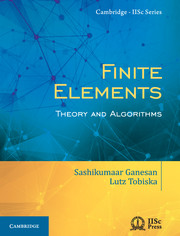Refine search
Actions for selected content:
8124 results in Fluid dynamics and solid mechanics
Contents
-
- Book:
- Cellular Flows
- Published online:
- 22 January 2018
- Print publication:
- 08 February 2018, pp v-xii
-
- Chapter
- Export citation
6 - Vortex Breakdown in a Sealed Cylinder
-
- Book:
- Cellular Flows
- Published online:
- 22 January 2018
- Print publication:
- 08 February 2018, pp 319-402
-
- Chapter
- Export citation
4 - Formation of Cells in Thermal Convection
-
- Book:
- Cellular Flows
- Published online:
- 22 January 2018
- Print publication:
- 08 February 2018, pp 126-243
-
- Chapter
- Export citation
3 - Two-Fluid Creeping Flows
-
- Book:
- Cellular Flows
- Published online:
- 22 January 2018
- Print publication:
- 08 February 2018, pp 48-125
-
- Chapter
- Export citation
1 - Introduction: Flow Cells and Mechanisms of Their Formation
-
- Book:
- Cellular Flows
- Published online:
- 22 January 2018
- Print publication:
- 08 February 2018, pp 1-14
-
- Chapter
- Export citation
9 - Cellular Flows in Vortex Devices
-
- Book:
- Cellular Flows
- Published online:
- 22 January 2018
- Print publication:
- 08 February 2018, pp 495-554
-
- Chapter
- Export citation
Afterword
-
- Book:
- Cellular Flows
- Published online:
- 22 January 2018
- Print publication:
- 08 February 2018, pp 555-558
-
- Chapter
- Export citation
Index
-
- Book:
- Cellular Flows
- Published online:
- 22 January 2018
- Print publication:
- 08 February 2018, pp 571-574
-
- Chapter
- Export citation
5 - Swirl Decay Mechanism
-
- Book:
- Cellular Flows
- Published online:
- 22 January 2018
- Print publication:
- 08 February 2018, pp 244-318
-
- Chapter
- Export citation
7 - Celluar Whirlpool Flow
-
- Book:
- Cellular Flows
- Published online:
- 22 January 2018
- Print publication:
- 08 February 2018, pp 403-449
-
- Chapter
- Export citation
Acknowledgments
-
- Book:
- Cellular Flows
- Published online:
- 22 January 2018
- Print publication:
- 08 February 2018, pp xiii-xiv
-
- Chapter
- Export citation
2 - Creeping Eddies
-
- Book:
- Cellular Flows
- Published online:
- 22 January 2018
- Print publication:
- 08 February 2018, pp 15-47
-
- Chapter
- Export citation
References
-
- Book:
- Cellular Flows
- Published online:
- 22 January 2018
- Print publication:
- 08 February 2018, pp 559-570
-
- Chapter
- Export citation
Copyright page
-
- Book:
- Cellular Flows
- Published online:
- 22 January 2018
- Print publication:
- 08 February 2018, pp iv-iv
-
- Chapter
- Export citation
A NOTE ON NAVIER–STOKES EQUATIONS WITH NONORTHOGONAL COORDINATES
- Part of
-
- Journal:
- The ANZIAM Journal / Volume 59 / Issue 3 / January 2018
- Published online by Cambridge University Press:
- 05 February 2018, pp. 335-348
-
- Article
-
- You have access
- Export citation
COUPLE MICROSCALE PERIODIC PATCHES TO SIMULATE MACROSCALE EMERGENT DYNAMICS
- Part of
-
- Journal:
- The ANZIAM Journal / Volume 59 / Issue 3 / January 2018
- Published online by Cambridge University Press:
- 30 January 2018, pp. 313-334
-
- Article
-
- You have access
- Export citation
MODELLING HYDROGEN CLEARANCE FROM THE RETINA
- Part of
-
- Journal:
- The ANZIAM Journal / Volume 59 / Issue 3 / January 2018
- Published online by Cambridge University Press:
- 25 January 2018, pp. 281-292
-
- Article
-
- You have access
- Export citation

Cellular Flows
- Topological Metamorphoses in Fluid Mechanics
-
- Published online:
- 22 January 2018
- Print publication:
- 08 February 2018

Ordinary Differential Equations
- Principles and Applications
-
- Published online:
- 14 December 2017
- Print publication:
- 11 May 2017

Finite Elements
- Theory and Algorithms
-
- Published online:
- 14 December 2017
- Print publication:
- 16 March 2017
